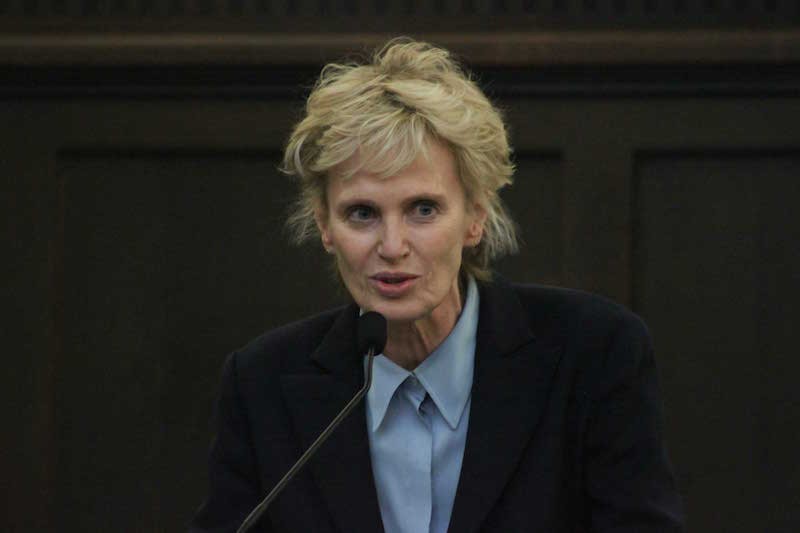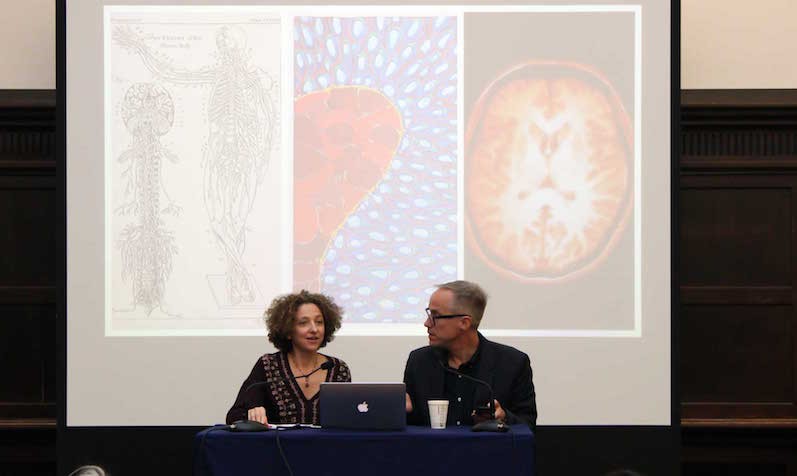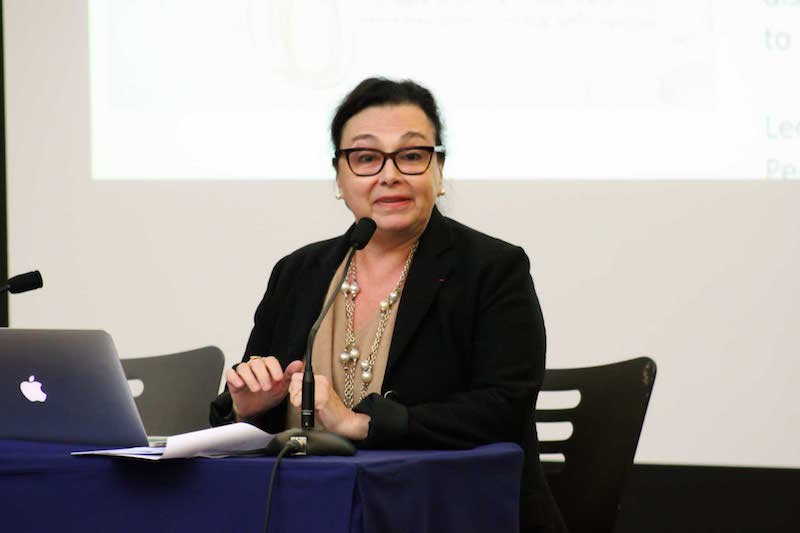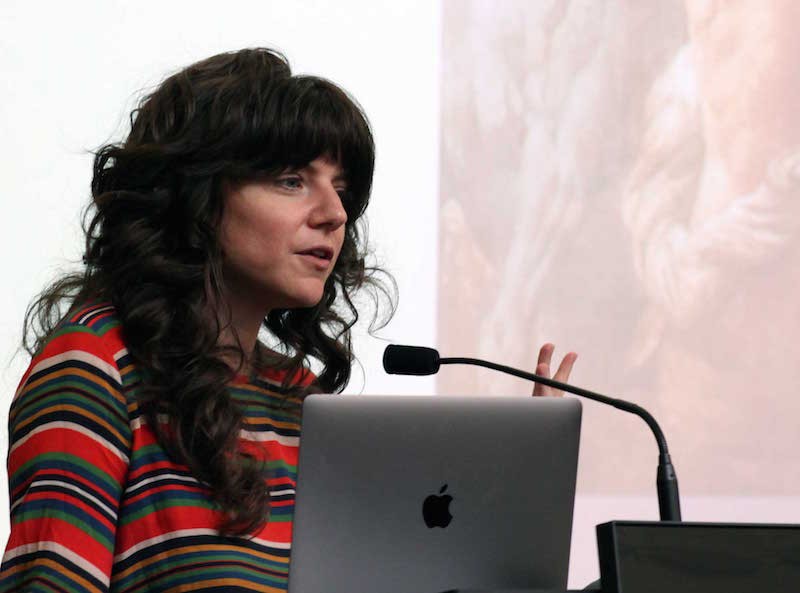A Meeting of Minds (and Bodies) at the Three Souls Conference

On the second day of The Three Souls in the History of Medicine and Philosophy conference at Reid Hall, the conference’s co-convener Noga Arikha invited her audience to participate in some light morning yoga. Arikha asked those in attendance to close their eyes and take a deep breath in, then out. In the silence that followed, the diverse conference members consisting of psychoanalysts, neurologists, writers, artists, philosophers, biologists, psychiatrists, neuroscientists, and historians were momentarily united as Arikha invited the audience to remember their bodies in what to that moment had been an event where most had been using their minds.
The discussion following Arikha’s talk sparked debate about the value of yoga, a light-hearted disguise for the real conflict that was hanging over the conference’s fascinating two days: the body vs. mind. As Arikha and her co-convener Justin E. H. Smith noted in their introductory talk on 5th October, The Three Souls event was always going to be ‘a bit of an experiment.’ The unnecessary but rigid divide between medicine and the humanities means that events like October’s The Three Souls conference are scarce. However, the rarity of events that explore the medical humanities means that The Three Souls conference was not only experimental, but also ambitious, brave, and essential.

Over the course of two days, the conference’s speakers explored the titular ‘three souls’ and their history. Neurologist Laura Bossi, from Sphere, Paris, began the conference with an in-depth exploration and analysis of the history of the writing, philosophy, and science on the three souls. Beginning with Plato and his writing on the soul and women’s wandering wombs, Bossi expertly charted the development of Plato’s thoughts through to da Vinci, Freud, and MacLean’s three brains. Bossi’s talk perfectly established the day’s following discussions, with Sophia Connell from Birkbeck College, London and Karl-Léo Schwering of Paris-Diderot University giving talks on the ontological and conceptual meanings of Aristotle’s idea of the soul and the challenge of applying animism to medicine, respectively. To conclude the evening, philosopher Ohad Nachtomy and biology philosopher Philippe Huneman of CNRS, Paris 1 Sorbonne ended the evening with two distinct talks on the three souls. Nachtomy approached the idea of the soul and the self from a particularly philosophical point-of-view, noting the confusion of talking about the “brain” and the “body” separately when they are part of the same entity. To introduce Huneman’s more scientific talk, which explored natural history, experimental physiology, and Kantianism, Huneman proposed a series of ideas and questions to continue exploring, including: the movement of souls to faculties to functions, the relation between natural history and physiology, and the concept of the ghost. Huneman discussed the discrepancies between Leibniz’s Mechano-teleology (or the soul as correlative to the body) against Stahl’s animism, as well as Bichat’s physiology and the question of how to distinguish between “vie organique” and “vie animale.”

The second day of the conference opened with co-convener Justin E. H. Smith, of Paris 7, quoting Philosopher Walter Charlton’s quip that ‘life is perpetual death.’ Using Aristotle’s paradox of the soul as air and the air as soul, Smith explored questions of what it means to be and the acts of respiration, digestion, and inhalation. Following Smith, psychiatrist George Makari of Cornwell Weill, New York, showcased Descartes’ ‘disastrous’ answer to the ‘seat of the soul,’ the pineal gland. Makari pointed out that Descartes was wrong to think everything in biology can be thought of as a machine. Simultaneously, Makari noted the competing notions of the natural mind, questioning if the mind can be healthy or sick. He then explored the relation between the soul and melancholy, linking the crisis of cultures being built around the rational soul with cases, movements, and ideas such as witchcraft and Enthusiasm. To follow, neurologist Laurent Cohen of the Hôpital Pitié-Salpêtrière used his more practical experience to explore fragmentation and disconnection. Cohen gave a fascinating account of one of his patients who not only believed he had lost his arm, but also felt that a new one that he had seen in a butcher’s shop had been sewn onto his body. These ideas of dissociation and connection continued to be explored in Arikha and philosopher and bioethicist Kathryn Tabb’s following talks. Arikha noted the divide between the body and the academic mind, extending this betrayal of the physical from the mental to the lack of discourse and relationship between theory and practice. Tabb, of Columbia University, gave a fascinating talk on madness in the sensitive soul, largely focusing on John Locke’s concern with the management of understanding. ‘The sensitive soul,’ said Tabb, ‘allows us to look at our mental illness through phenomenology in a way Descartes wouldn’t allow.’

Bioethicist Didier Sicard and historian Charles Wolfe each focused on the physicality of the soul. Sicard noted the lack of humanity in the sciences, reminding his audience of the fact the physician can no longer touch their patient’s body. Wolfe, on the other hand, would have pointed out the human cannot touch their soul since the soul is, he argued, not about the mind but about life. Philosopher of science Marta Spranzi returned to a more clinical and scientific analysis through her talk on the disorders of consciousness, questioning the ethics of consciousness, awareness, and the soul. Finally, to conclude the speakers before writer Siri Hustvedt’s keynote, neuroscientist Manos Tsakiris of Royal Holloway, Warburg Institute, London brought together theory and science as he turned to questions of interiority and exteriority within and surrounding the human body. Tsakiris noted how the advancement of the sciences, for example the creation of MRI scans, allows us to see the brain as a locatable entity. Exploring self-identification theories from Foucault, Lacan, and Freud, Tsakiris posed questions that represented a split between ways of thinking and ways of being, for example the exteroceptive body versus the interoceptive body, or psychoanalytical thinking versus cognitive thinking. Tsakiris’ talk was summed up with this question: how does anybody become somebody?
After a series of talks that focused on theories, philosophy, and science largely from the minds of men, and therefore focusing on male bodies, writer Siri Hustvedt pertinently called attention to the female body and the female soul. Hustvedt recalled themes and ideas that appeared in each of the previous speaker’s talks, from Bossi’s exploration of Plato’s wandering wombs to Tsakiris’ brief discussion of the role of memory in creating and/or influencing the mind and the soul. Hustvedt deconstructed a range of theories and ideas from philosophers and scientists including Alfred North Whitehead, Descartes, D. W. Winnicott, and, of course, Plato. A particular theme Hustvedt stayed with derived from a statement by Descartes, in which he said, ‘as regards to my parents, they did not even make me.’ Hustvedt was not interested in disproving Descartes with scientific fact, but rather explored why and how Descartes would choose to say something that separated him from those that brought him into the world, specifically the woman who brought him into the world. This desire to detach oneself from the female body derives from Plato, with Hustvedt arguing that, despite the proliferation of both physical and symbolic pregnancy within Plato’s Symposium, the female body – specifically the placenta – has been ignored and undermined by scientists, philosophers, and even painters.
‘Where,’ asked Hustvedt, ‘are the paintings of women giving birth?’ The simple answer is, in the Western canon they do not exist because in the eyes of many women do not exist, either. The fourth soul, argued Hustvedt, can be found in the placenta, is the placenta. The placenta is the dialogical organ, and it symbolises humanity’s maternal origin, our radical dependence on others, and the terrifying borderlines between male and female, between human and animal, and between body and soul. Hustvedt argued that ignoring the placenta is correlative to the ignoring of the maternal. In terms of scientific discovery, Hustvedt reminded her audience of neoteny, or the retention of juvenile characteristics. For animals this is abnormal, but for humans this is a fact of our species. Hustvedt drew on palaeontologist Stephen J. Gould, who explained that human cultures might have bloomed because of the fact we do not stand up after birth. We are born too early.
Throughout her talk, Hustvedt also importantly drew upon the theories of proto-feminist and feminist scientists and writers, including Margaret Cavendish and Simone de Beauvoir. Hustvedt used de Beauvoir’s work to note that the body and the mind can be subjected to labours and laws, and that our habits are deeply ingrained thoughts that become us. When exploring matter, Hustvedt returned to Cavendish’s philosophy that sense and reason are all in one nature; that matter is not dead, but instead self-moving and self-living. We may never completely answer Tsakiris’ question, ‘how does anybody become somebody?’ but Hustvedt’s keynote, along with the talks by the conference’s speakers, shows that the important action is to continue creating questions that not only attempt to find answers, but also attempt to overcome borderlines.
Bringing together academics, philosophers, writers, and scientists from institutions from around the world such as the Hôpital Pitié-Salpêtrière in Paris to the new Narrative Medicine department at Columbia University in New York was inevitably going to spark debate and cause more questions than answers. However, thanks to the open-mindedness the speakers and guests brought to the Three Souls conference, one left the conference feeling as though this was the intention of the two days: to elicit more questions than answers, and to bring the two ends of the academic disciplines that rarely look eye-to-eye – the sciences and the humanities – into conversation through Plato, Aristotle, Margaret Cavendish, John Locke, and, yes, even yoga.
Article by Sinéad McCausland